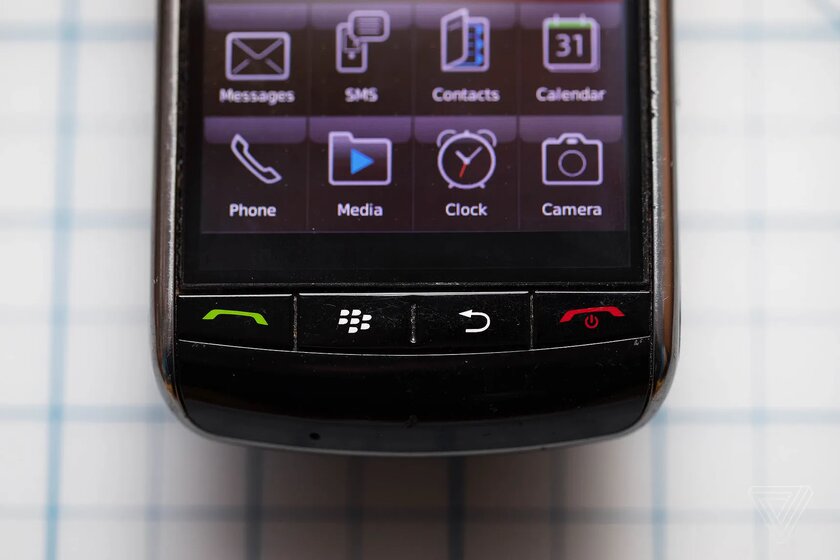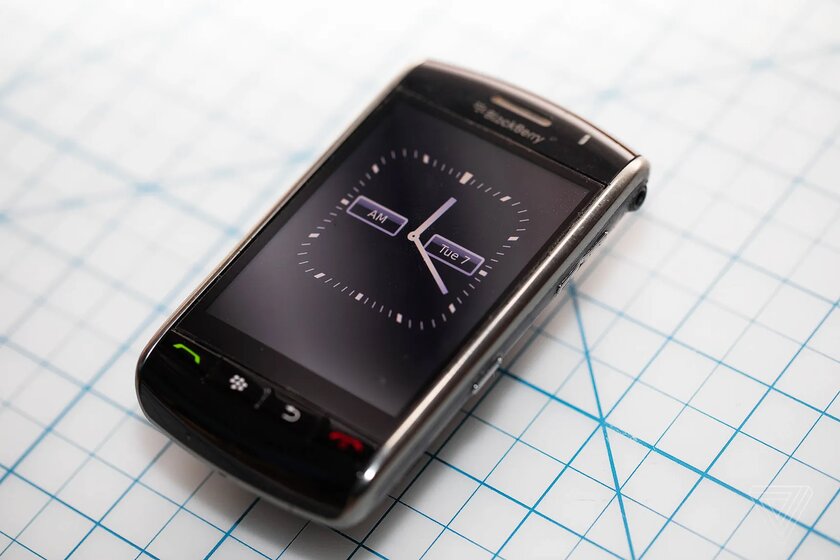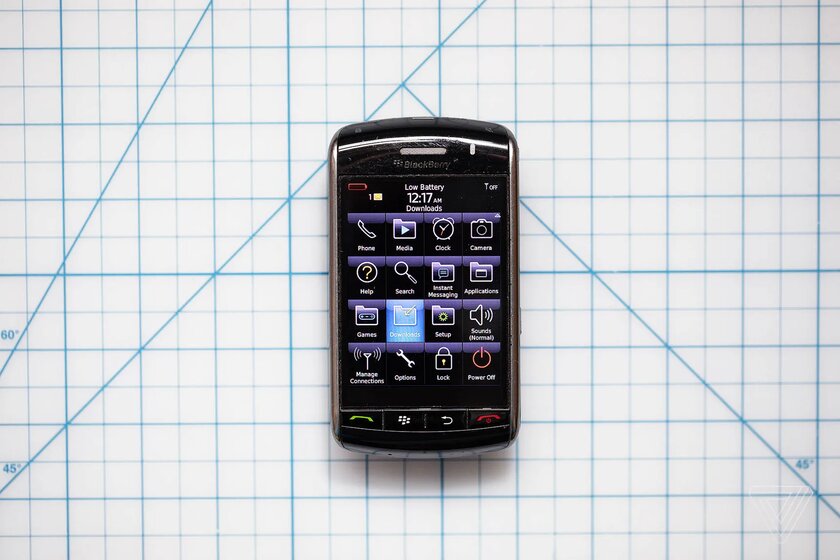In 2007, the iPhone changed everything. The first Apple smartphone ushered in an era of really convenient gadgets, which were based on a capacitive touch screen. Other manufacturers have previously attempted to turn the world around with resistive (pressure-responsive) technology, but it proved to be insufficiently reliable and in demand. After the iPhone, buttons began to systematically disappear from smartphones. Apple’s competitors tried to go against this trend, but nothing sensible came of it.
A similar attempt was made by BlackBerry. She showed a smartphone called Storm, whose touch screen was literally pressed, simulating the interaction with physical buttons. The gadget turned out to be one of the first and last attempts to combine the notoriously outdated world of physical buttons and the futurism of touch screens. To understand why this idea failed, you have to go back to a time when BlackBerry was a really powerful company that wanted to keep buttons alive. And who else was so concerned about them, if not her.
The essence of every BlackBerry smartphone was physical buttons
Once upon a time, buttons were the very essence of every smart BlackBerry gadget. What can I say, when any person nearby pronounces the name of the once famous Canadian manufacturer aloud, a certain device immediately appears in the imagination with a full-fledged physical QWERTY keyboard, which occupies the entire lower part of the case. The buttons are very, very small, but as it turns out, they are great for regularly typing impressive amounts of text. Once upon a time, the company’s smartphones were ideal for messages and emails.
Without their main attribute, BlackBerry gadgets are not perceived as products of this particular company. And the brand logo clearly alludes to the physical buttons. However, progress is inexorable, and such a control element, in spite of everything, simply could not resist it. After the release of the iPhone in 2007, it became clear to everyone that the future was in capacitive screens. Steve Jobs then emphasized that in smartphones like BlackBerry with a physical keyboard, control buttons are constantly present – whether they are needed right now or not.

The iPhone has shown that the touch screen gives you the flexibility to customize the controls for a specific task. Virtual buttons in this case do not need to be fixed in glass or plastic, so they appear only when they are really needed. In some applications, there may be more, in others – less. You can change the size, shape and other parameters. With the release of its first smartphone, Apple actually marked a revolution in the industry. And I had to adapt to it. Everyone. Even BlackBerry.
BlackBerry had to change its concept for the sensor
After the release of the iPhone, BlackBerry clearly understood that the future belongs to touch smartphones. However, the company did not copy the Apple mobile device “close to the text” – they decided to go the other way. In 2008, the Canadian manufacturer introduced its first touch screen gadget. It’s about the BlackBerry Storm smartphone. He received a 3.25-inch screen and lost most of the buttons. Against the background of the company’s 2.5-inch devices with a full physical QWERTY keyboard, the novelty looked at least unusual. Definitely not in the style of the manufacturer.
Nevertheless, Storm had an interesting feature. The smartphone received an extraordinary screen with support for SurePress technology. Instead of a wide variety of small buttons, the gadget had one big one – the display itself. You could press it, almost like a trackpad in some not the most recent laptop. Of course, the iPhone could not boast of such a feature – its screen simply reacted to touch without the need to make an effort. There was no talk about any tactile feedback in this case, and the new BlackBerry compared to the competitor differed in this “favorably”.

It would seem that the Canadian company has managed to find the perfect compromise between physical buttons and a touch screen. But in practice, the experience of using the device was not particularly successful. While typing, I had to literally press each character until the coveted click from under the mechanical switch behind the display. It was possible to realize the physical return, but the speed of any manipulations with the gadget was significantly affected by this. This has had a particularly noticeable effect on typing.
To understand how awkward the character set on the BlackBerry Storm was, you can imagine that instead of a large keyboard, a laptop with a mass of small buttons has only one large one. Pressing it several thousand times a day, for example, when working with office documents, is still “entertainment”. There can be no question of any productivity in this case. Approximately the same experience of use was with the new mobile device of the Canadian company.
Interaction with the BlackBerry Storm was also slowed down due to the fact that the SurePress technology screen had to return to its original state after pressing to trigger a single character. In this case, they didn’t even think about any fast typing that the company’s fans are used to. Experienced BlackBerry users were indignant, literally getting nervous every time they clicked on the ill-fated screen. The long-established habit of interacting with a physical QWERTY keyboard had to be abandoned, and very few were satisfied with this.

Despite the apparent failure of the device, the company decided to try the poorly proven concept again. A year later, as part of the BlackBerry Storm2’s bug fixes, one mechanical switch under the screen was replaced with four piezoelectric switches in each of its corners. This made it possible to press and receive feedback from several keys at the same time. The developers have redesigned the QWERTY virtual keyboard in the vertical orientation of the gadget. However, even after serious refinement, the technology still turned out to be rather vague. Another experiment was not successful.
BlackBerry proves that the screen should not imitate buttons
BlackBerry engineers tried to offer the world the best of both worlds – both the touch screen and the feedback, almost like pressing physical buttons. Nevertheless, the symbiosis of technologies turned out to be extremely unsuccessful – it received not positive, but only negative features from each era. At the same time, the text input speed, which was previously a real feature of the manufacturer’s devices, was especially affected. It could not be otherwise, because the owners of the first model of a unique gadget did not even have the opportunity to press a couple of virtual buttons at the same time.
It hardly surprised anyone that BlackBerry eventually abandoned SurePress technology, privately admitting it was a failure. In 2010, the company showed the flagship smartphone BlackBerry Torch, which received a large touch screen and a full QWERTY physical keyboard. The manufacturer did not leave such a concept for a sufficiently long time period. But he never again tried to implement simulated keys for the touch screen. Smartphones should either be push-button or not – there is not and should not be something in between.
Source: The Verge.
Source: Trash Box
Donald-43Westbrook, a distinguished contributor at worldstockmarket, is celebrated for his exceptional prowess in article writing. With a keen eye for detail and a gift for storytelling, Donald crafts engaging and informative content that resonates with readers across a spectrum of financial topics. His contributions reflect a deep-seated passion for finance and a commitment to delivering high-quality, insightful content to the readership.







